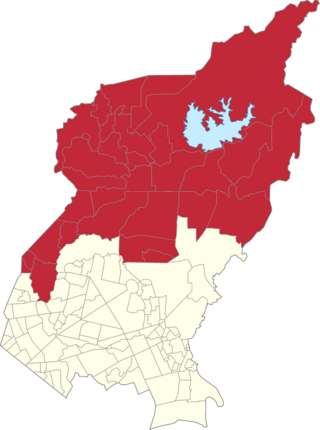
Delfin Albano, officially the Municipality of Delfin Albano, is a 4th class municipality in the province of Isabela, Philippines. According to the 2020 census, it has a population of 29,928 people.

Antipas, officially the Municipality of Antipas, is a 2nd class municipality in the province of Cotabato, Philippines. According to the 2020 census, it has a population of 26,817 people.

Leon B. Postigo, officially the Municipality of Leon B. Postigo, is a 4th class municipality in the province of Zamboanga del Norte, Philippines. According to the 2020 census, it has a population of 27,639 people.

Tampilisan, officially the Municipality of Tampilisan, is a 4th class municipality in the province of Zamboanga del Norte, Philippines. According to the 2020 census, it has a population of 24,680 people.

Vincenzo A. Sagun, officially the Municipality of Vincenzo A. Sagun, is a 5th class municipality in the province of Zamboanga del Sur, Philippines. According to the 2020 census, it has a population of 24,852 people.

The State of the Nation Address is an annual address by the president of the Philippines to a joint session of the Congress of the Philippines. Mandated by the 1987 Constitution, the speech is delivered every fourth Monday of July at the Plenary Session Hall of the Batasang Pambansa Complex in Batasan Hills, Quezon City.

The legislative districts of Quezon City are the representations of the highly urbanized city of Quezon in the various national and local legislatures of the Philippines. At present, the province is represented in the House of Representatives of the Philippines by its six congressional districts, with the districts' representatives being elected every three years. Additionally, each district is allotted six seats in the Quezon City Council, creating a total of thirty-six elective seats in the legislature.
The legislative districts of Zamboanga City are the representations of the highly urbanized city of Zamboanga in the various national legislatures of the Philippines. The city is currently represented in the lower house of the Congress of the Philippines through its first and second congressional districts.
The Interim Batasang Pambansa was the legislature of the Republic of the Philippines from its inauguration on June 12, 1978, to June 5, 1984. It served as a transitional legislative body mandated by the 1973 Constitution as the Philippines shifted from a presidential to a semi-presidential form of government.
The legislative districts of Makati are the representations of the highly urbanized city of Makati in the various national legislatures of the Philippines. The city is currently represented in the lower house of the Congress of the Philippines through its first and second districts.
The legislative district of Pateros–Taguig is the combined representation of the independent municipality of Pateros and eastern part of the highly urbanized city of Taguig in the Congress of the Philippines. The city and municipality are currently represented in the lower house of the Congress through their lone congressional district.
The legislative districts of Caloocan are the representations of the highly urbanized city of Caloocan in the various national legislatures of the Philippines. The city is currently represented in the lower house of the Congress of the Philippines through its first, second, and third congressional districts.
The legislative districts of La Union are the representations of the province of La Union in the various national legislatures of the Philippines. The province is currently represented in the lower house of the Congress of the Philippines through its first and second congressional districts.
The legislative districts of Cebu City are the representations of the highly urbanized city of Cebu in the various national legislatures of the Philippines. The city is currently represented in the lower house of the Congress of the Philippines through its first and second congressional districts.
A national plebscite and local plebiscites were held on April 7, 1981 in the Philippines. The plebiscite was set to amend the following revisions made by the Interim Batasang Pambansa, pursuant to Batasang Pambansa Blg. 122:
A national referendum-plebiscite was held on October 16–17, 1976 in the Philippines in which the majority of the barangay voters approved the continuation of Martial Law and ratified the proposed amendments to the Constitution substituting the Regular Batasang Pambansa with the Interim Batasang Pambansa, pursuant to Presidential Decrees Nos. 991, 1031, and 1032.
The legislative districts of Taguig are the representations of the highly urbanized city of Taguig in the Congress of the Philippines. The city is currently represented in the lower house of the Congress through its lone congressional district.

Batasan Hills is a barangay of Quezon City, Philippines. The barangay was originally planned as the National Government Center of the Philippines. The Batasang Pambansa Complex, which sits atop the Constitution Hill, is the legislative session hall of the House of Representatives of the Philippines. The Sandiganbayan, a special appellate court, is also located here.

Batasan Road, is a six-to-ten lane circumferential highway located in the barangays of Batasan Hills, Bagong Silangan, Payatas, and Commonwealth, which are located all in Quezon City, Philippines. The road serves as a route towards the Batasang Pambansa Complex, where the House of Representatives of the Philippines is located.

Quezon City's 2nd congressional district is one of the six congressional districts of the Philippines in Quezon City. It has been represented in the House of Representatives of the Philippines since 1987. The district consists of the eastern barangays bordering Marikina, San Mateo and Rodriguez. From 1987 to 2013, it is the most populous district in the country, encompassing the northern part of Quezon City commonly called as Novaliches, until it was redistricted in time for the 2013 election. Just like its pre-2013 composition, it still includes the Batasang Pambansa, the seat of the House of Representatives. It is currently represented in the 19th Congress by Ralph Wendel Tulfo of the Partido Federal ng Pilipinas (PFP).










